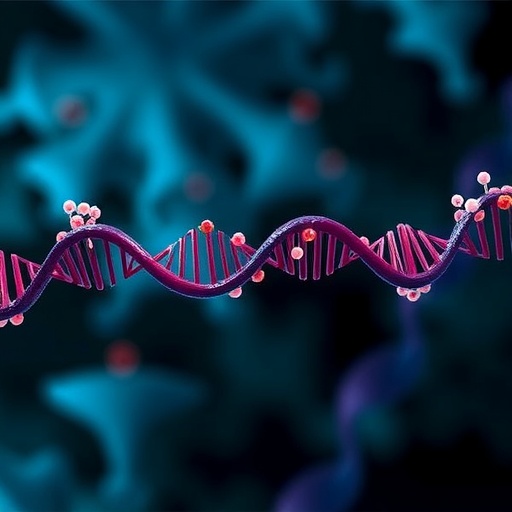
In the complex world of agriculture, the battle against plant diseases has taken center stage, particularly in the quest to protect cereal crops that feed billions. A recent study published in BMC Genomics showcases significant advancements in understanding the molecular mechanisms behind gossâs bacterial wilt and leaf blight resistance in corn. This research, spearheaded by a team led by M. Sayari and including prominent scientists such as S.V. Good and D. Trubetskoy, employs cutting-edge RNA-Seq technology to unveil the intricacies of cornâs defense mechanisms against these devastating diseases.
Gossâs bacterial wilt and leaf blight, caused by the bacterium Clavibacter michiganensis subsp. nebraskensis, poses a severe threat to corn production globally. As farmers fight the dual challenges of crop yield and food security, understanding plant-pathogen interactions becomes increasingly critical. The team leveraged RNA-Seq analysis to delve into the corn genome, providing insights into gene expression patterns that play a pivotal role in resilience against these bacterial infections. This revolutionary method allows researchers to capture a snapshot of which genes are activated when corn plants are under stress, granting a broader understanding of the plant’s natural defense systems.
The research reveals that certain genes are consistently upregulated in corn when exposed to goss’s bacterial wilt and leaf blight. These genes form an integral part of the plant’s immune response, contributing to the overall fitness and health of the plant. By identifying these genes, the study lays the groundwork for potential genetic improvements in corn, aiming to enhance resistance through breeding programs. This not only serves to protect the crop but also aids in reducing the dependence on chemical treatments that can have detrimental effects on the environment.
Gene candidates highlighted in this study are particularly intriguing. Some of them belong to well-characterized families that are known for their role in plant defenses. For instance, resistances genes that encode for proteins with roles in signal perception and transduction were found to be significantly expressed during pathogen challenge. This opens doors to genetic engineering approaches that could facilitate the introduction of these resistance traits into susceptible corn varieties, empowering farmers to cultivate more resilient crops.
Moreover, the utilization of RNA-Seq technology allowed the researchers to assess the timing and magnitude of gene expression changes, providing a dynamic view of the plant’s response cycles. This temporal analysis is crucial; it does not merely document that certain genes are active but showcases their activation under specific conditions, which could vary depending on environmental factors. Understanding these nuances will be key in creating more robust disease management strategies that can adapt to the ever-evolving landscape of agricultural threats.
In addition to gene identification, the study also emphasizes the potential for metabolomic analyses. By examining not only the genes but also the metabolites produced in response to pathogen stress, researchers can gain insights into the biochemical pathways that underpin disease resistance. This holistic approach enhances our understanding of the interconnectedness of genetic and metabolic responses, allowing for a more comprehensive picture of plant immunity.
Collaborative efforts with other research groups are already underway, aiming to combine findings from this RNA-Seq analysis with data on phenotypic responses to goss’s bacterial wilt and leaf blight. The ultimate goal is to correlate specific genetic markers with observable traits in corn crops, facilitating breeders in their endeavors to select for resistant varieties more efficiently. As the agricultural community faces the realities of climate change and increasing pest pressures, such collaborative research will be pivotal in securing sustainable food systems.
One of the main takeaways from this study is the importance of genomic resources for crop improvement. With genomic data at hand, it becomes feasible to prioritize specific traits that confer advantages in disease resistance. This approach marks a shift from traditional plant breeding, where characteristics were selected based on observable traits, to a more informed strategy rooted in genetic understanding. As geneticists and agronomists work together, the prospect of engineering crops that can withstand the pressures of climate change and disease becomes increasingly attainable.
As we continue to explore the genetic underpinnings of disease resistance, the implications of such studies extend beyond corn alone. The methodologies and findings can serve as a model for other crops susceptible to bacterial infections, broadening the impact across various agricultural systems. Furthermore, researchers are excited about the possibility of cross-species application of discovered resistance genes, potentially feeding into a wider network of global food security efforts.
The collaborative nature of scientific research is further highlighted through the involvement of multiple institutions and funding agencies dedicated to advancing agricultural research. The team’s diverse expertise brought forth a wealth of knowledge in fields ranging from molecular biology to bioinformatics, demonstrating the power of interdisciplinary approaches in tackling complex agricultural challenges.
As the results of this study circulate through the scientific community, the hope is that they will inspire further investigations into other critical diseases affecting crops worldwide. Agricultural experts are eager to apply the newfound understanding of genetic resistance to enhance not just corn, but a variety of staple foods that are the backbone of global sustenance. Situating research in a pressing context, the work encourages a proactive response to emerging pathogens which have the potential to jeopardize food security.
In conclusion, the research team led by Sayari and colleagues has opened new avenues in understanding the molecular mechanisms behind gossâs bacterial wilt and leaf blight resistance in corn. The integration of RNA-Seq technology has provided a powerful tool for identifying key genes and pathways involved in plant defense. As the agricultural sector stands at the crossroads of innovation and tradition, the findings from this study underscore the importance of leveraging scientific advancements to secure a sustainable future in food production.
The implications for breeding programs and genetic research are tremendous, reinforcing the need for continued investment in agricultural science. We look forward to witnessing the impact of these findings in breeding healthier, more resilient corn varieties that can withstand diseases and climatic challenges, ultimately ensuring food security for future generations. The collaboration and insights from this research serve as a beacon of hope in the ongoing quest to combat agricultural diseases through innovative science.
Subject of Research: Molecular mechanisms and candidate genes for gossâs bacterial wilt and leaf blight resistance in corn.
Article Title: Unveiling molecular mechanisms and candidate genes for gossâs bacterial wilt and leaf blight resistance in corn through RNA-Seq analysis.
Article References: Sayari, M., Good, S.V., Trubetskoy, D. et al. Unveiling molecular mechanisms and candidate genes for gossâs bacterial wilt and leaf blight resistance in corn through RNA-Seq analysis. BMC Genomics 26, 755 (2025). https://doi.org/10.1186/s12864-025-11830-4
Image Credits: AI Generated
DOI:
Keywords: Corn, goss’s bacterial wilt, leaf blight, RNA-Seq analysis, molecular mechanisms, disease resistance, genetic improvement, agricultural research.
Tags: advancements in agricultural genomicsClavibacter michiganensis and corncombating corn diseases through genomicscorn disease resistance researchfood security and crop yieldgene expression patterns in corngenetic insights for sustainable agriculturegoss’s bacterial wilt in cornleaf blight resistance in cereal cropsmolecular mechanisms of corn defenseplant-pathogen interactions in cornRNA-Seq technology in agriculture




